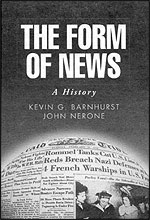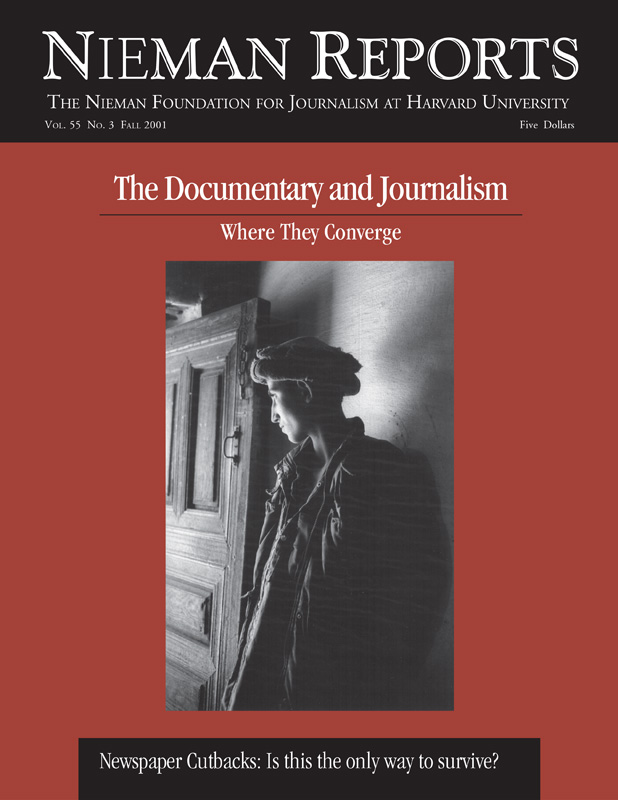
The Form of News: A History
Kevin G. Barnhurst and John Nerone
The Guilford Press. 326 Pages. $35.Oh, what a difference a century makes.
One hundred twenty-five years ago, crowds numbering in the tens of thousands were astonished by the speed, power and ingenuity of a working newspaper printing press on display at the Centennial Exposition in Philadelphia.
Visitors, standing in awe, witnessed this technological marvel, a manifestation of the might of a 100-year-old nation just moving into the world limelight. In less than a century, the newspaper had a respected and feared monopoly in the information business, an institution like no other.
Kevin Barnhurst and John Nerone recall this unique moment in “The Form of News,” their well-referenced new book on the history of the American newspaper from colonial times till the present.
Of course, today, no one is in awe of the newspaper, not even an insider. Competition is everywhere, and the newspaper suffers further from a lack of interest from a non-reading public. The technology appears primitive by micro-chip standards, and publishers cannot seem to satisfy the profit expectations of Wall Street as they cut staff and content. As Barnhurst and Nerone remind us, it wasn’t always that way. The press “was a source of peculiar energy of the newly imperial public,” they write.
“The Form of News” is not your usual newspaper history, often heavy on personality, family squabbling, and politics. It is quite light on the colorful moments that make newspapers such a special institution. The book is an academic, sometimes clinical and dispassionate, examination about how social, economic and cultural forces led to the development of the modern, professional product we call today’s newspaper.
The authors dispel popularly held notions that technological advances have driven change in the look and feel of the newspaper. They claim that inventions such as the telegraph (wire news) and the telephone (rewrite desks, different ways of writing) were factors but not shaping forces. Whether one agrees or not (the point may be best decided in bars frequented by journalists), the authors put in commendable research in the development of the book, which delves into the relationship between democratic civic culture and the look and feel of the newspaper.
By form, the authors mean “everything a newspaper does to present the look of the news. …We mean the persisting visible structure of the newspaper, the things that make The New York Times, for example, recognizable as the same newspaper day after day although the content changes,” they write.
So in many ways the book is a history of the layout and design of news, including typography, habits of illustration, and use of photography. But it also tracks genres of reportage and how newspapers compartmentalized to meet the needs of a busy public.
At times, the text places too much importance on underlying cultural forces as the driver of change, and not enough on the pioneer writers and editors who shaped the newspaper and its history. Surely, Hearst and Pulitzer, and Greeley and Scripps, characters all but important figures to a one, deserve some mention in the transformation of the newspaper as a mass medium.
Nevertheless, Barnhurst and Nerone cover ground that has rarely been tread before. And they do it with a keen eye on historical context. I’m a former writer who calls himself a born-again newspaper designer. I came late to the visual form, appreciating later than most that readers appreciate the design and feel of a publication before assessing its contents.
So I was intrigued in learning how illustration and photography developed in newspaper pages, that it took many years for objective photography to supplant often-subjective drawings, long after the technology had been mastered. How bylines developed. How headline styles evolved to the point whereby they capture the essence of stories rather than provide an outline as they did in 1900. And I found it fascinating that most of the creative leaps forward in the look of newspapers found their way through advertising, not news.
The authors contend that a design revolution did not take place during the 1970’s and 1980’s, despite the fact that most newspapers made significant (and sometimes overnight) strides in creating a more organized, colorful and attractive look. They see those design forces gradually infiltrating culture through the late 19th and early part of the 20th century, only moving at a faster pace when the modern art movement arrived with the Armory Show of 1913, which showcased the art and design ideas of Europe. This would surprise some newcomers to the craft, who think the design movement began with the introduction of USA Today in 1982.
And I was impressed at how the authors have skillfully broken down the American newspaper development into a series of stages—printerly newspapers (“bookish and homemade”), Victorian newspapers (“crowded and busy”), and modern newspapers (“purposeful and organized”). Further, they trace the type and style of the newspaper from Industrial to Professional to Corporate, with improvements along the way.
The authors, in their forward, say they have attempted to mirror the rise and decline of American civic culture in this work. I’m not sure they have succeeded here, but they have kicked up loads of interesting facts along the way.
We do know one thing. Today’s newspaper is a product of a developing market revolution that started long ago. The authors talk about how newspapers first wrote about market changes, then were cheerleaders for them—at least in terms of modern improvements in transportation and communication. Of course, those commercial forces took years to become the dominant determining factors in U.S. culture.
But that is the case today. Fewer family-owned enterprises remain, and more and more dailies are part of publicly owned chains that are driven largely by forces connected to the bottom line. We’re trying but, on the whole, it’s becoming more and more challenging for anyone to practice effective journalism. Look what we’ve unleashed.
Yes, the newspaper is not the guardian of civic culture as it once was. And it will be increasingly difficult to recapture that role if we continue to cut budgets and news staffs to maintain the kind of profit margins that other industries crave.
Warren Watson is director of extended learning at the American Press Institute. A newspaper reporter, editor and designer for 26 years, he is the second vice president of the Society for News Design and will be its president in 2003.



